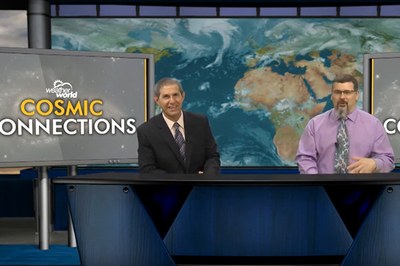Recurring ‘Weather World’ segment takes viewers to space, beyond

"Weather World" host Jon Nese, left, said he invited astronomer Chris Palma to be on the show because the sciences overlap. “These courses are embedded in our program,” Nese said. Palma, who has appeared on the show since 2011, says he does so because he's excited to spotlight exciting advances in his field. IMAGE: PENN STATE
Jon Nese, host of Penn State’s “Weather World,” says you can trace the roots of a longtime partnership with the astronomy and astrophysics department to the ancient Greek meaning of the word “meteorology.”
Loosely translated, it means the study of things high in the air. While the Greeks may have underestimated the true breadth of the universe, they were right on the similarities.
The close relationship between the two disciplines prompted Nese, a teaching professor and associate head for undergraduate programs in the Department of Meteorology and Atmospheric Science, to link up with Christopher Palma, astronomer and associate dean for undergraduate students in the Eberly College of Science (ECoS).
Read the full story here: Recurring ‘Weather World’ segment takes viewers to space, beyond
